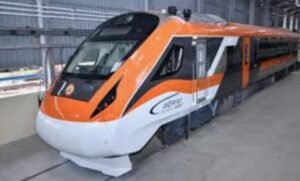
Bullet Train China vs Bharat
> Potential Growth Ahead
🔴 In China
China’s first bullet train, the CRH (China Railway High-speed) train, began operation on April 18, 2007. This marked a significant milestone in China’s transportation history and was a major step in the development of the country’s high-speed rail network.
The initial service was on the line between Beijing and Tianjin, covering a distance of about 117 kilometers (73 miles). The CRH trains could reach speeds of up to 350 km/h (217 mph), showcasing China’s advancements in high-speed rail technology. Since then, China’s high-speed rail network has expanded rapidly, becoming one of the largest and most advanced in the world.
As of 2024, China operates over 3,800 high-speed trains, including both CRH (China Railway High-speed) and CR (China Railway) series. These trains are used across the extensive high-speed rail network that covers more than 42,000 kilometers (about 26,000 miles). This fleet includes various models, such as the CRH380A, CRH380B, and the newer CR series trains, which are designed to accommodate the high-speed travel requirements and varying regional needs across China.
🟢 In Bharat :
As of 2024, India does not yet have a high-speed rail network on the scale of China’s, but it is developing its first high-speed train service. The most notable project is the Mumbai-Ahmedabad High-Speed Rail Corridor, also known as the Bullet Train Project, which is being implemented with the help of Japan’s Shinkansen technology.
The construction of this corridor, which is expected to cover around 508 kilometers (316 miles), is ongoing, with the goal of introducing high-speed trains capable of reaching speeds up to 320 km/h (199 mph). The project aims to commence operations in the next few years, potentially around 2026-2027.
In addition to this, India is planning several more high-speed rail projects to expand its network, but none are yet operational as of 2024.
As of 2024, India’s total railway network spans approximately 68,000 kilometers (about 42,000 miles). This extensive network includes both broad-gauge and narrow-gauge lines, covering various regions across the country. The Indian Railways network is one of the largest in the world and serves as a crucial component of India’s transportation infrastructure, handling millions of passengers and a substantial volume of freight annually.
As of 2024, India has introduced a total of 22 Vande Bharat Express trains. The Vande Bharat Express is a series of high-speed trains designed and manufactured in India, offering enhanced comfort and faster travel times compared to conventional trains. These trains are part of India’s efforts to modernize its rail infrastructure and provide improved passenger experiences on key routes across the country.
The Vande Bharat Express trains are equipped with features such as automatic doors, onboard Wi-Fi, and advanced safety systems. The network of Vande Bharat trains is expected to expand further in the coming years as additional trains and routes are developed.
India’s railway authorities have ambitious plans for the Vande Bharat Express trains. The target is to introduce around 400 Vande Bharat trains over the next several years. This expansion is part of a broader initiative to modernize the Indian Railways network, with the aim of enhancing passenger comfort, speed, and efficiency.
The projected rollout includes new routes connecting various major cities and regions, improving connectivity and reducing travel times across the country. The exact timeline for achieving this goal may vary based on production schedules, infrastructure development, and other logistical considerations.
> Aastha Fintech


